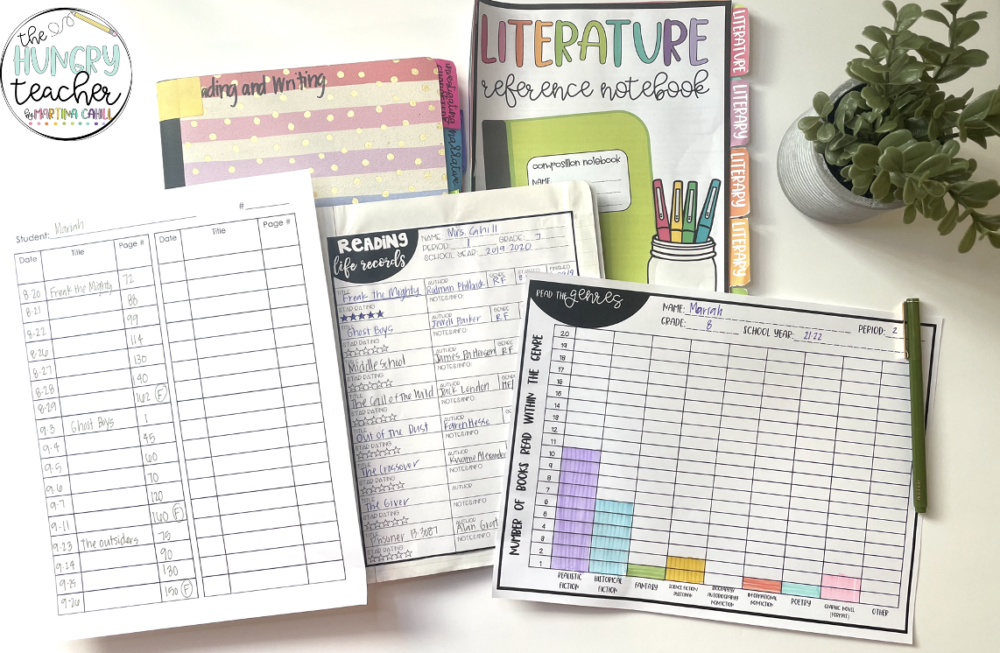hey friend!
I'm Martina.
I provide practical, time-saving strategies that actually work—so you can engage your students, teach effectively, and reclaim your time from the exhausting planning-grading cycle.
Browse Our ELA Resources
Silent Reading in Middle School ELA
SILENT READING IN MIDDLE SCHOOL ELA: The Good, The Bad, and The Ugly
Over the years, I feel like I have really worked hard and advocated for having “Silent,” or “Independent,” reading time in my middle school ELA classroom. It’s something I am super passionate about.
I have always been a reader, but I can tell you that none of my reading love really came from any of my middle school or high school English classrooms. I had some great teachers too! But none of them (with the exception of a sixth grade English teacher-who I didn’t really appreciate at the time) gave us time to silent read in class. The exception would be that they might have gave us time to read any of the novels they required us to read (I don’t remember that happening though).
Like I said, I am a reader, but I definitely went through a lot of chunks of time in those years where I didn’t read much for pleasure.
This was at at time when cell phones weren’t quite a thing yet either. I always wonder how much more reading I would have done, if I had had time in class to at least get into a book, but even more so, I think about how many of my classmates didn’t consider themselves readers.
My memory of those times obviously isn’t as strong as it used to be, but I can barely remember any of my classmates reading just for pleasure.
Even more so, I remember being shocked when one of my male high school classmates pulled out a book during an “off-hour” we had together. I knew very few males (especially of high school age) who read for pleasure at that point in my life.
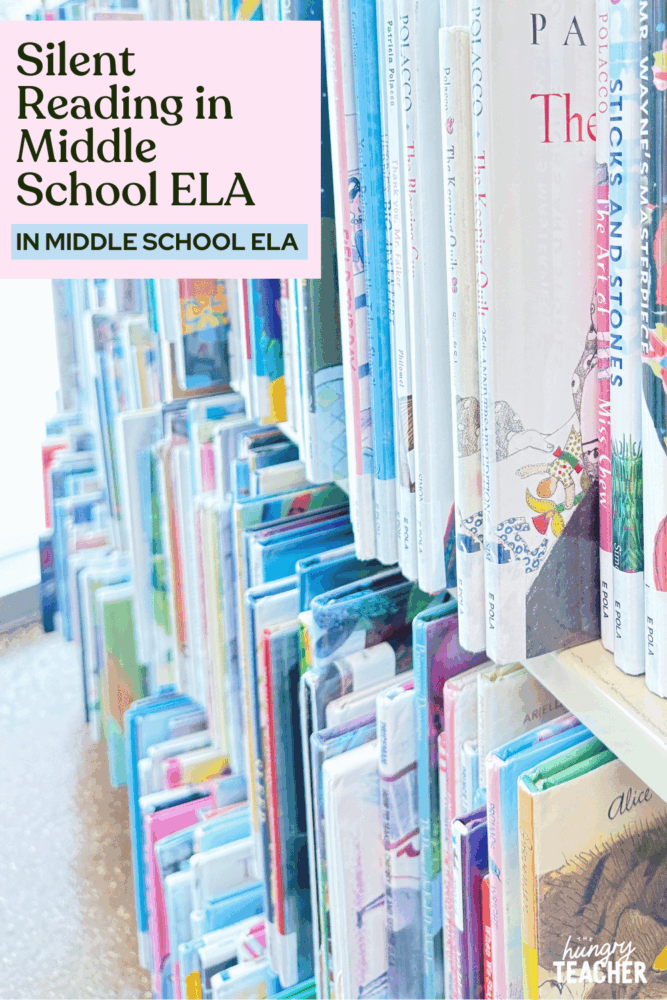
BECOMING A MIDDLE SCHOOL ELA TEACHER
Anyway, when I became a middle school ELA teacher I set out to do everything I could to create life-long readers. I talk about it pretty often, and I am pretty passionate about not using incentives or rewards to get kids to read, even though I teach middle schoolers.
As someone whose students come from a very heavy Accelerated Reader and incentivized/rewards reading background, I am fighting an uphill battle from the start.
Many of my students HATE reading by the time they get to me, and when I tell them we don’t do Accelerated Reader in middle school anymore, many of them think that means they don’t have to read anymore.
This is EXACTLY what happens when you incentivize reading. I feel like this should be proof enough that programs that incentivize reading are SO detrimental in relationship to their long-term effects.
It’s easy to say these incentives work when you only see the short term, but it’s the long-term and life-long habits that we’re really trying to create here.
When the incentive is gone, then these kids don’t know how to self-select, how to read for pleasure, or (the worst of all) how to pick a book that isn’t an “AR book.”
Those are the absolute worse results we could ask for. We want life-long readers.
The work is harder, more time-consuming, and even frustrating at times, but it is more worthwhile in the long-term results.
I want to just about die when kids ask me, “Is this an AR book?” My response is always, “I literally have no idea, but it is a book, and you can read it.” I’m not sure if it breaks my heart or makes me happy when I see how excited they get when I say they can read whatever they want.
SCHOLARY ARTICLES
To show that I’m not just talking from only my personal experience, here are links to two different scholarly articles that actually looked into the detrimental effects of Accelerated Reader.
- Does Accelerated Reader Work?
- Disrupting the Flow: The Detrimental Effects of Accelerated Reader on Student Motivation
Here are some other links to some of the best reading teachers and authors out there that validate the problems with incentivizing reading:
- “After Accelerated Reader” by Pernille Ripp
- “Some Thought and Recent Articles About Accelerated Reader” by Jen Robinson
- “How to Accelerate a Reader” by Donalynn Miller
_________________________________________________
RESEARCH BASED THINKING
The more I talk about this type of thinking (research-based thinking to be clear) the more I realize that I am not alone in that many teachers know that it’s best practice to encourage students to become life-long readers through the conversations, lessons, and modeling we do in our classroom.
I have worked hard to read and implement the ideas and strategies from books like Reading in the Wild and The Book Whisperer by Donalyn Miller, Readicide by Kelly Gallapher, In Defense of the Read Aloud by Steven Layne, and basically anything Pernille Ripp writes.
I know I am not the first or the last teacher who works hard to do this, BUT I am also a real life teacher who implements these kinds of things and knows that there is implementation, and then there is the reality. Again. I am a HUGE ADVOCATE for silent reading in all classrooms, but also know that it will NEVER be perfect.
That’s essentially the whole point of this blog post: to encourage teachers to not stop trying to get your middle schoolers (or any age really) to use silent reading time to read books for enjoyment. Because some days IT IS SO DANG HARD to want to keep trying. It can feel defeating and hopeless.
I am not saying this because misery loves company, but I am saying this so you can see that as someone who pushes, advocates, and constantly talks about the importance of silent reading time has and will continue to have the same struggles you do or will have too.
I’m also saying this because it’s going to seem harder and less gratifying than simple incentive programs. Just know that it does pay off, you just may not see it like you feel like you should, because again, it’s a long term result.

_________________________________________________
MIDDLE SCHOOL ELA CLASS PERIOD SCHEDULE
So what does silent reading look like in my middle school ELA classroom?
Here is a snapshot of my daily class schedule. We have had 55, 60, and 65 minute class periods in the four years I have been here.
There is obviously variations and change that occur, especially when we are doing a writing unit. When we do a writing unit, we typically do a bell ringer or mentor sentence, then I do a 10-15 minute mini-lesson, they write for 30-40 minutes, and then I try to get them to do silent reading (I struggle with this but will talk more about that later).
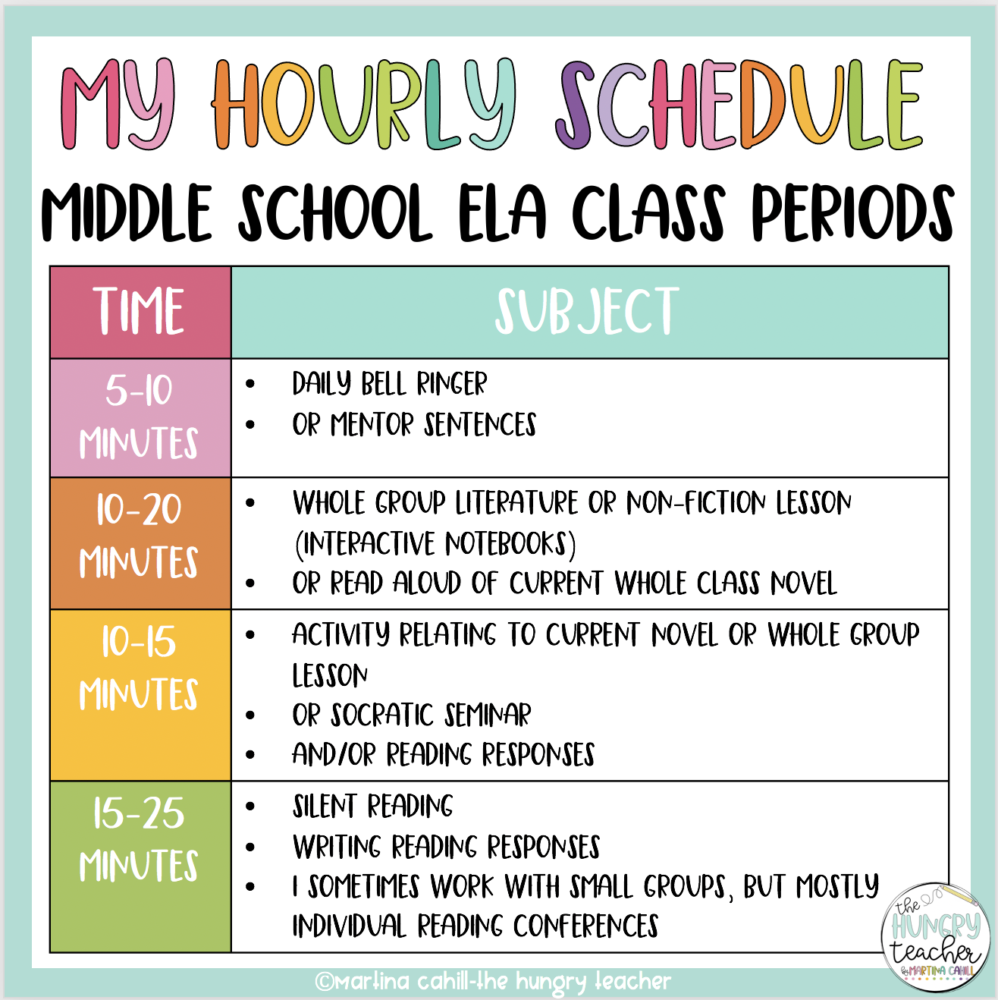
_________________________________________________
WHAT DOES SILENT READING TIME LOOK LIKE?
I keep it really simple.
I teach our lesson, do an application activity, and typically say something like, “When you are finished with your work, you may move to read silently.”
They are allowed to move around the room and sit in the various couches or comfy chairs and/or get one of the pillows or bean bags to sit on. I don’t have a system in middle school because it works out over time anyway. They all find the spots they like and after the first few weeks, the “fighting” goes away. It’s very minimal though.
After they all get settled, I then do a status of the class. I thought this idea came from Donalyn Miller, but have been corrected on its origins. Now I just can’t remember or find where it came from. I’ve seen tons of variations of this, but the general idea is to ask each student what book they are reading and what page they are on each day. This replaces reading logs (those are a terrible teaching practice anyway) and gives you so much valuable information.
You can tell who is reading, who is abandoning books, who is making up how much they are reading and so on. Basically it allows you to see who you need to conference with, who needs help finding books, ideas for next books to suggest to students, and who your true readers are.
Your true readers are a valuable asset because they can help recommend books to classmates. I am most definitely not an expert on all reading genres, while some of my readers are.
CLICK HERE or on the image below to get the freebie version.
_________________________________________________
LAYING THE GROUNDWORK FOR SUCCESS
It’s really important to note that I don’t get my middle schoolers reading by saying things like, “Pick a book and read,” and then just hope for the best. I work REALLY hard to read relevant professional development texts that have shown me how to effectively implement silent reading with middle schoolers.
There is so much to be learned from these research-based practices of these authors but here are my big takeaways:
You will have to teach your students how to self-select:
This is especially true if they come from Accelerated reading, incentivized reading, or required reading heavy environments. They haven’t been taught to find books solely based on interests. They have been taught to look for points, reading levels, or just been plain told what to read.
Giving them book stacks is one way to do this.
When a student asks for a book, it’s easy to just pick a highly popular one or one you think they might like. This doesn’t help them learn how to self-select and nine times out of ten, those kids just shove it back on the bookshelf at the end of class waiting for you to do the same thing again tomorrow.
-
- Book stacks are basically a curated stack of books for students who need help learning how to pick books they like. I simply ask them what types of books they like to read and then we head to the library to find 5-10 books that fit their criteria.
- Some honestly can’t remember a book they’ve liked, except Diary of a Wimpy Kid or Big Nate in third grade or something. That’s honestly probably not their fault. I tell them, “That’s perfect. That’s a starting point.” Then I just pick some Middle School: The Worst Years of My Life books or anything by Gordan Korman. I honestly might hand them those same books again just so they can remember what it’s like to enjoy reading.
- I hand them 5-10 of those types of books and literally explain that these books are in their criteria of books they think they like, but that it won’t help either of us if I pick a book each time they need one. Now it’s their turn to read the synopsis on the back of each and try to start 1-3 of them to see if it’s something they might like to commit to and finish.
Graphic Novels are also one of the best reading tools I have ever been given as a teacher.
If I have students who struggle with stamina, “hate reading,” or are just plain being difficult, then I hand them a varied stack of graphic novels. I hook about 10-15 kids a year on reading, just by handing them graphic novels.
Reading Conferences can be so many different things to so many different people...
…but the point of them is to help your students find books they want to read so they can continue to be truly independent readers all year long. I used to think I had to have a perfectly organized binder, with perfectly printed teacher prompt pages so that I could ask students specific questions about their reading. I do sometimes still do that, but really I tend to conference when I notice a student has abandoned the last five books we’ve worked to pick out, or that they’re talking to friends during silent reading, or that they keep reading the same book over and over. These are things I notice that are starting points in the conversation, so we can work to help them find a book or books that they will want to finish.
You can CLICK HERE to get some of my conference forms FOR FREE or you can always purchase the guided reading set by clicking here or on the images below.

_________________________________________________
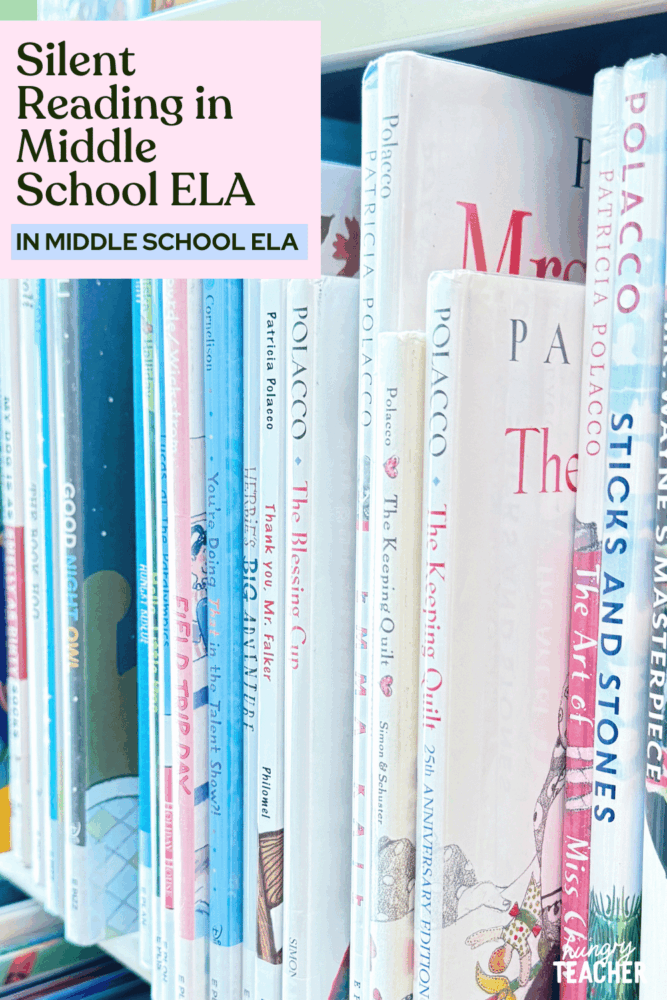
WHAT DOES IT ACTUALLY END UP LOOKING LIKE?
Below is the good, the bad, and the just plain ugly of what ends up happening during independent reading, and also some other aspects of classroom time where students need to read on their own.
Just know I am telling you this from a place of wanting you to see how it’s totally worth it, but also how it may take you all day, every day, all year long, and you still won’t have a perfect classroom of all kids reading during silent reading time.
I hope it shows you that even it seems like everyone else’s classes are all reading when they’re supposed to, the truth is they’re not, OR it took SO MUCH WORK to get to the point where many students are reading.
_________________________________________________
THE GOOD
Every single year, I have parents who come to me and say, “My kid hasn’t read in years, and now I can’t get them to stop.” Is it all of the parents? No. It it the vast majority of parents? Also, no. BUT even if I get one kid who hasn’t been reading, in a middle school language arts class no less, to start reading again, then I have accomplished the main goal. I do get multiple emails every single year though, and they are almost always when I am feeling so defeated by it all.
During silent reading time, which I work really hard to be 15-20 minutes, but no less than 10, most kids do read. I am VERY lenient with cell-phones during my class periods, EXCEPT during silent reading time.
During silent reading time, I HAVE to be crazy about cell phones, or they will for sure play on their phones. I personally can even get distracted by my phone, especially if my book is kind of dragging along. I even have a pretty good stamina for reading, but when my stamina is fading, I will start checking my phone. How can I possibly expect my middle schoolers to not get distracted?
It works, for the most part, because it’s the only time I will make them take their phones to the office if they’re caught with it. I even tell them they can ask to send a quick text or something during this time, as long as they just ask before they do it, but I will NOT tolerate it during silent reading time under any circumstances, especially if they try to be sneaky.
During this 10-20 minutes each day, I help kids find book stacks if needed, do conferences with students who still aren’t seeing themselves as readers, and eventually I even do my own silent reading during this time. I used to stress that I needed to be doing something during this time, but more and more I realized many of this kids many not be exposed to other reader examples in their lives. I have to become the example of what a reader looks like. I read a mix of “adult” novels and novels in my classroom. Almost every time I read a book from our classroom, kids are lined up waiting or me to finish, so they can read it next.
Also, during this time, like I said before, many of my students are reading. In the beginning of year, when we’re in the honeymoon phase, I have almost 100% reading in some capacity. I would say it drops to about 60% (just keeping it real) after the honeymoon phase dies off. When the 60% happens, is when I get to work doing book stacks and conferences. We get up to about 80% of students reading and I will talk about that in the following section (THE BAD).
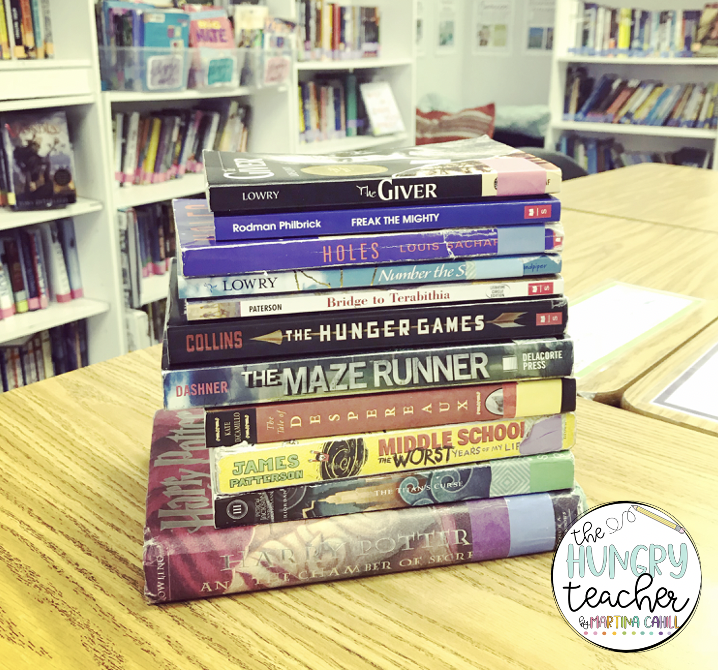
_________________________________________________
THE BAD
I mentioned above that we start the year at almost 100% reading, we drop to about 60%, then I work to get us up to 80% of kids reading in the first few months. I feel like the rest of the year, we are at a solid 80% of kids reading during this time. This means, I almost always have about 5-6 kids in every class period that are trying to age me ten years in one school year haha. I spend the rest of the year pulling out all the stops, buying all types of books, magazines, audiobooks, edgy books, books being made into movies, graphic novels, etc. and just plain reading to them to get them into books.
I call this, “THE BAD,” section of this post but it’s not that bad. I am just saying, 80% of my students get in a good groove of reading. This 20% never really seems to dwindle as the year goes on, and it can be so frustrating for me. Some are being stubborn, some insist that no books are interesting, and some genuinely just struggle to sit and read because their bodies have such a hard time sitting still for that long. I don’t give up, and I’m sure some progress is made every single year, but as a middle school ELA teacher, it can be really difficult to see exactly what progress has been made.
I wish I could say all of them eventually love reading and call themselves readers by the end of the year, and it’s not for lack of trying on my part, but some just don’t every really stick to books and become true readers. They just don’t.
THE BAD PART TWO
Another kind of section of “THE BAD,” is that we also just have good and bad days with silent reading. Some are my fault, some are not my fault haha. I REALLY struggle to keep up with silent reading time during our writing units. It’s mostly because my kids are writing furiously, and even though they’ll have time the next day to read, they don’t want to stop their writing groove and I just let them continue writing during silent reading time.
If I was self-contained this would be an easy fix, but as someone who teaches them both reading and writing, it’s just not my hill to die on. They are still writing, which requires reading most of the time. It only last or one to two weeks, when we are in the writing heavy portion of the unit, so I’ve learned to just not stress about it.
Other times, we’ve had an assembly, a fire drill, someone starts a random conversation and just won’t stop, and it’s honestly just not a good silent reading session.
I also have a way better luck with my 7th graders than with my 8th graders every year. I’m notoriously bad at following through, so my 8th graders know how to get away with more by year two with me.
My seventh graders are still willing to try and please me (but that isn’t really the goal of creating true readers) and will read more easily.
The point is, I always have some class periods that are just way easier to get to read, while others are much more of struggle each year.
_________________________________________________
THE UGLY
There are kids who do not finish a single book in my English class ALL YEAR LONG. I am not going to lie to you and say they all finish at least one book.
I even have required texts/whole class novels and we do multiple rounds of books clubs. Both of which have a graded aspect to them in terms of their reading and responding to the reading, and they STILL DON’T finish a book the entire year.
It’s PAINFUL, disheartening, and beyond frustrating. These students who refuse to read (many would rather cheat, take shortcuts, but some just have it in their stubborn brains that they aren’t readers so they do everything to prevent themselves from becoming one) make me want to bribe, incentivize, and just plain quit trying with them. In full transparency, in cases where these students distract others who are trying to read, I have resorted to these techniques just to get through a class period. (Though I’ve never resorted to Accelerated Reader EVER). Even when I know I shouldn’t, I’ve done it.
I get up again the next day and try again (the right way) each time, but just know that even I just need to survive a class period some days. I honestly think it’s better some days if just one kid is being affected by their own bad choice (the one who refuses to read) instead of multiple kids being affected (the ones they’re trying to distract).
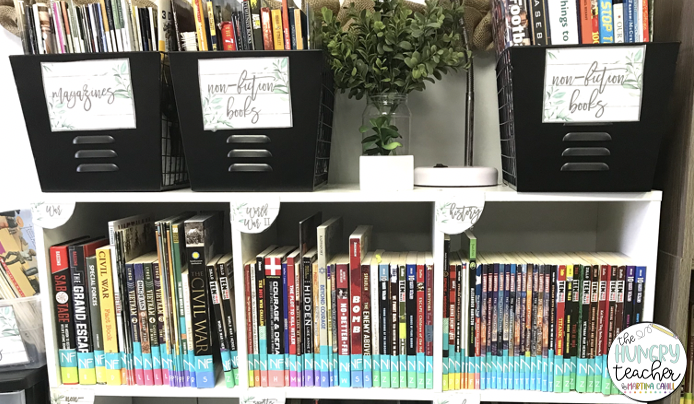
CLASSROOM LIBRARY ORGANIZATION
I always get asked about the colored labels on my book spines. This is not my idea or creation. They are organized alphabetically by author’s last name. I have a separate non-fiction section in my classroom (pictured above).
I have tried all the systems, and this is the only one that has lasted more than a year. When I did genre based bins, it drove me nuts for all three years I did it. My students and I alike struggled with books that it into multiple categories.
These are a resource from Molly Maloy at Lessons with Laughter. You can CLICK HERE or on the image below to purchase.
The most important thing to note is I have NEVER put labels on my books for any type of reason. If you go to any of the creators of Guided Reading or Leveled Text Set programs (besides Accelerated Reader) every single one of them will tell you that kids are not meant to know their “levels.” The levels were designed as a teacher tool, not a student category.
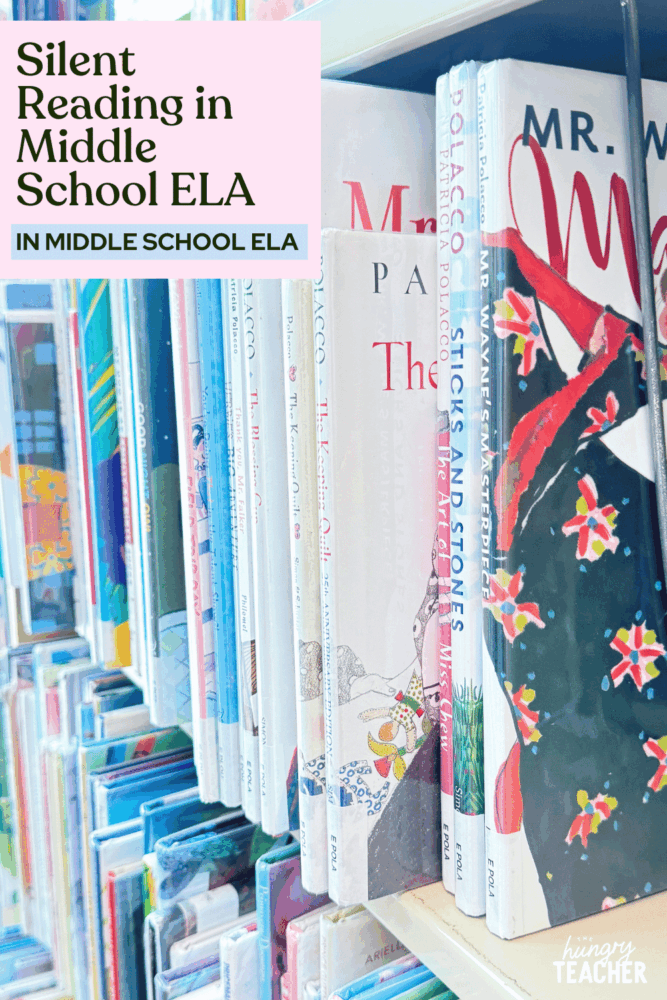
CLASSROOM LIBRARY CHECK-OUT SYSTEM
Again, I have tried all the systems and NOTHING has ever been perfect, and my current system is also not my idea. Soaring Sandy has an amazing tutorial on using a Google Form and Sheets. It is the best system I’ve used and doesn’t take a lot work on my end. CLICK HERE or on the image below to check out her tutorial. 
CLASSROOM LIBRARY ORGANIZATION
Lastly, if you want to see how my library has progressed, I have an entire organizational module that shows how it has changed and evolved over the last seven years as a classroom teacher. You can get all ten modules classroom organization modules sent to your inbox FOR FREE by clicking here, or you can CLICK HERE or below to purchase just the classroom library module.
Want a sneak peek at teaching The Hungry Teacher way—with support, structure, and strategy?
When you join the waitlist for The Hungry Teacher’s Hub membership, you get three free classroom-ready resources: a theme unit, an expository writing unit, and a grammar unit introducing mentor sentences. Plus, you’ll get immediate access to a selection of exclusives from the Hub, including editable sub plans, pacing guides, and more.
No strings attached. Just resources you can use right now—and a heads-up when the Hub opens.
3 Free Middle School ELA Units—yours to keep!
JOIN THE WAITLIST + A FREE GIFT
Where to next, line leader?
Welcome to The Hungry Teacher! We create resources that are easy to use, practical, and get results. Teach with confidence—and make it home before dinner.
xo, the hungry teacher
